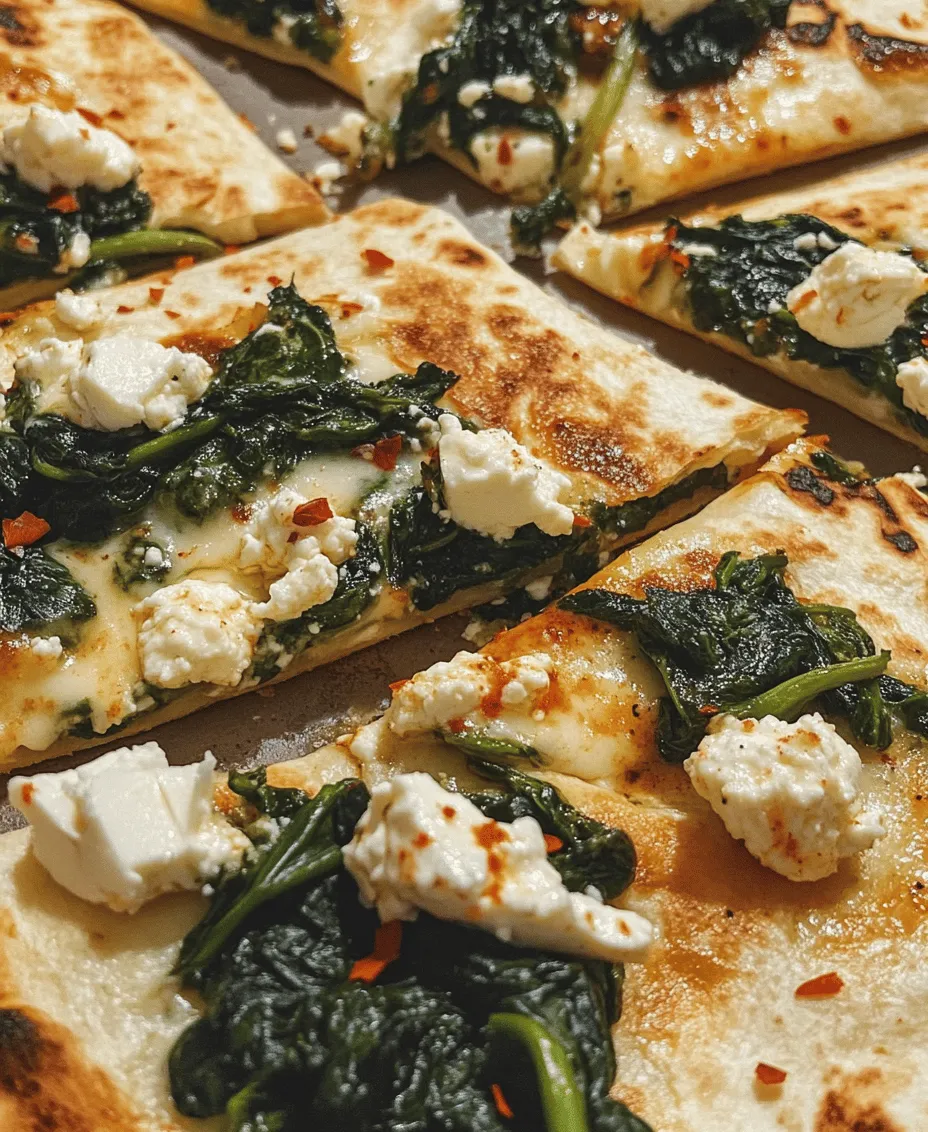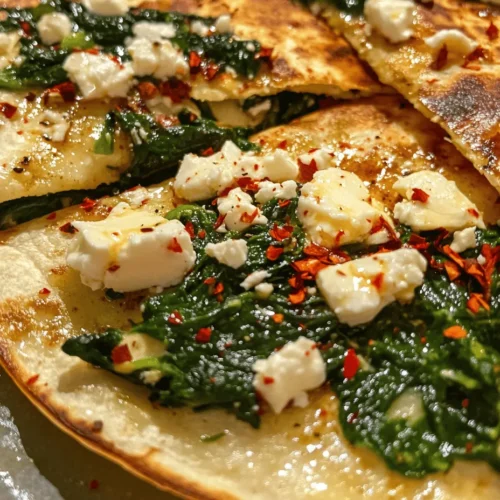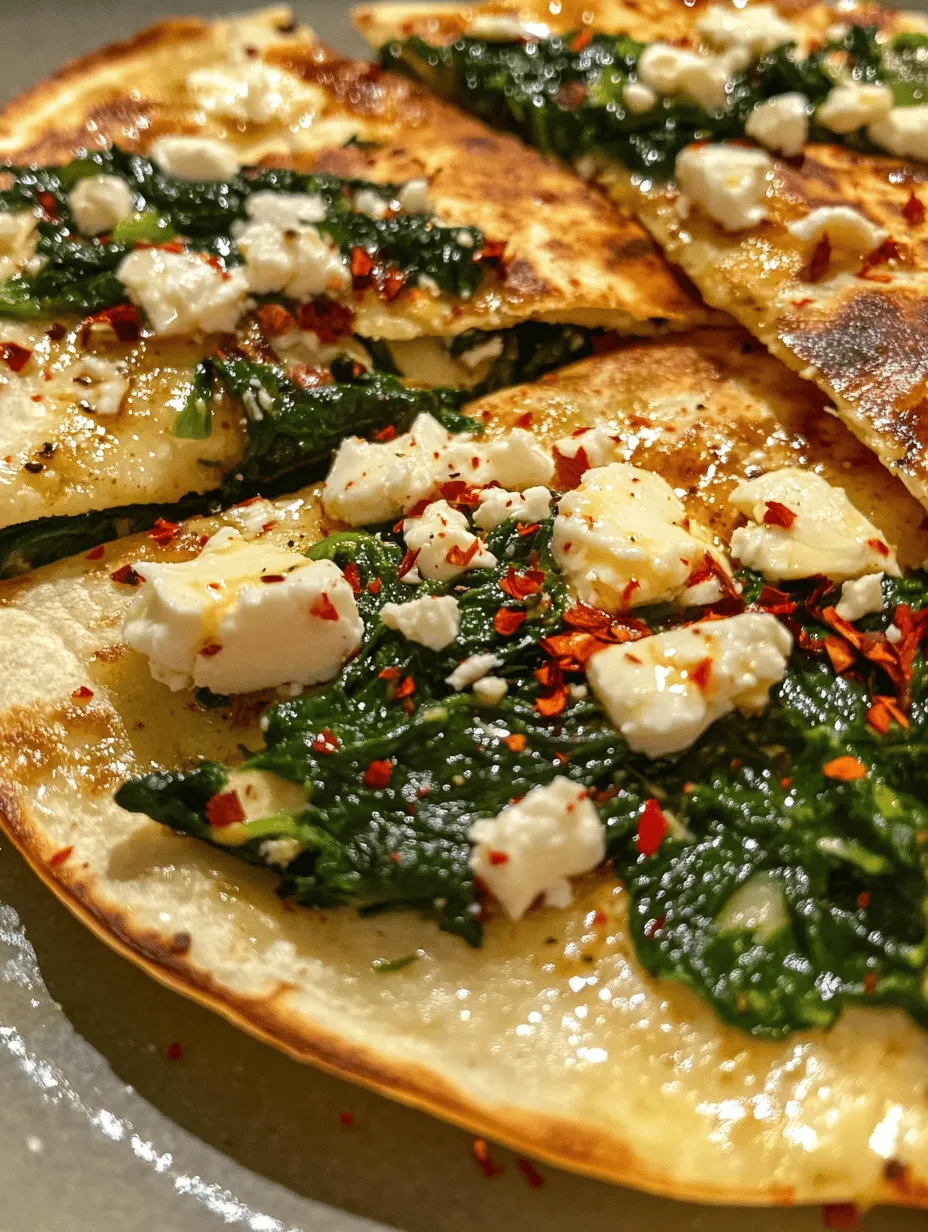Introduction
Quesadillas have taken the culinary world by storm, becoming a beloved staple in both Mexican and American cuisines. These delightful creations, characterized by their crispy tortillas filled with an array of savory ingredients, are not just versatile but also incredibly satisfying. Whether enjoyed as a quick snack, a light lunch, or a hearty dinner, quesadillas can cater to any palate. Their ease of preparation and the endless possibilities of fillings make them a favorite among home cooks and restaurant chefs alike.
Among the many delectable options for quesadilla fillings, Spinach and Feta Quesadillas stand out for their unique flavor profile and nutritional benefits. Spinach, a leafy green packed with vitamins and minerals, pairs beautifully with the tangy, creamy taste of feta cheese. This combination not only offers a delightful burst of flavor with every bite but also provides a host of health advantages. Spinach is rich in iron, calcium, and antioxidants, while feta adds protein and probiotics to the mix, contributing to a balanced meal.
The purpose of this article is to provide you with a comprehensive, step-by-step guide to creating these delicious Spinach and Feta Quesadillas. Whether you’re a seasoned cook or a kitchen novice, you’ll find that this recipe is approachable and rewarding. Let’s dive into the world of flavors and learn how to make these scrumptious quesadillas from scratch!
Understanding the Ingredients
When it comes to crafting the perfect Spinach and Feta Quesadillas, the quality of your ingredients plays a crucial role. Using fresh, high-quality components not only enhances the flavor but also elevates the nutritional value of your dish. Here’s a closer look at the essential ingredients that make this quesadilla irresistible:
Fresh Spinach: Nutritional Benefits and Flavor
Spinach is the star of this quesadilla. This leafy green vegetable is known for its numerous health benefits, making it an excellent choice for a nutritious meal. Spinach is low in calories yet high in vitamins A, C, and K, as well as folate, iron, and calcium. These nutrients are vital for maintaining strong bones, supporting immune function, and promoting overall health.
In terms of flavor, fresh spinach adds a mild earthiness that complements the sharpness of feta cheese beautifully. When cooked, it wilts down significantly, allowing it to blend seamlessly with the other ingredients.
Feta Cheese: A Unique Taste and Health Benefits
Feta cheese brings a distinctive tang and creaminess to the quesadilla. This crumbly cheese, traditionally made from sheep or goat’s milk, is lower in fat than many other cheeses, making it a healthier choice. Feta is also rich in calcium and protein, which are essential for muscle function and bone health.
The salty, tangy flavor of feta is particularly appealing, providing a sharp contrast to the mildness of the spinach. Its ability to melt slightly while retaining its shape adds a delightful texture to each bite of the quesadilla.
Mozzarella Cheese: Creaminess and Melting Properties
While feta cheese is a standout ingredient, adding mozzarella cheese enhances the quesadilla’s creaminess and provides excellent melting properties. Mozzarella is known for its stretchy texture and mild flavor, which balances the boldness of feta without overpowering the dish.
Combining these two cheeses creates a harmonious blend, ensuring that every bite is filled with a delightful mix of flavors and textures. This pairing not only makes the quesadilla more indulgent but also contributes to its overall nutritional profile.
Onions and Garlic: Aromatic Enhancements
No dish is complete without the aromatic touch of onions and garlic. These ingredients are essential for building a foundation of flavor. When sautéed, onions become sweet and caramelized, while garlic adds a savory depth that elevates the entire dish.
Both onions and garlic are known for their health benefits as well. They contain antioxidants and have anti-inflammatory properties, contributing to a healthier meal overall. Their savory aroma while cooking sets the stage for a mouthwatering experience.
Flour Tortillas: Choosing the Right Type
The choice of tortilla is vital for a successful quesadilla. Flour tortillas are the preferred option for Spinach and Feta Quesadillas due to their soft texture and ability to hold fillings without tearing. When selecting flour tortillas, look for ones that are fresh and pliable for the best results.
You can also experiment with different types of tortillas, such as whole wheat or gluten-free options, to cater to various dietary needs. The key is to choose a tortilla that complements the filling without overwhelming it.
Optional Ingredients: Adding Heat with Red Pepper Flakes
For those who enjoy a bit of spice, consider adding red pepper flakes to your Spinach and Feta Quesadillas. This optional ingredient can elevate the flavor profile, providing a pleasant kick that contrasts beautifully with the mildness of the spinach and the tanginess of the feta. Adjust the amount based on your heat preference, and don’t be afraid to experiment with other spices such as cumin or smoked paprika for added depth.
Preparation Steps for Spinach and Feta Quesadillas
Now that we’ve explored the essential ingredients, let’s move on to the preparation steps for creating these delightful quesadillas. The process is straightforward, but a few techniques can help you achieve maximum flavor and texture.
Sautéing the Vegetables: Techniques for Maximum Flavor
The first step in preparing your Spinach and Feta Quesadillas is to sauté the vegetables. This technique is key to unlocking the full flavor potential of your ingredients. Start by heating a tablespoon of olive oil in a skillet over medium heat.
Once the oil is hot, add diced onions and minced garlic. Sauté them for about 2-3 minutes until the onions become translucent and the garlic is fragrant. This initial step lays the groundwork for a flavorful filling.
Next, add the fresh spinach to the skillet. It may seem like a lot at first, but spinach wilts down significantly when cooked. Stir the spinach frequently, allowing it to cook for about 2-4 minutes until it is wilted and vibrant green.
Importance of Proper Heating and Timing
Proper heating and timing are critical in this process. If the heat is too high, the garlic can burn, imparting a bitter taste to the dish. Conversely, if it’s too low, the ingredients may not cook evenly, resulting in a lackluster filling.
Aim for a medium heat setting, allowing the vegetables to cook gently. Remember, the goal is to enhance their natural flavors without compromising their integrity.
Tips on Achieving the Right Texture
For the ideal filling texture, it’s important to achieve the right balance of moisture. While you want the spinach to be wilted, excessive moisture can make the quesadillas soggy. To prevent this, ensure that the spinach is fully cooked and the liquid has evaporated before removing the skillet from the heat.
After sautéing the spinach, allow it to cool slightly before mixing it with the cheeses. This will help maintain the right texture and prevent the quesadillas from becoming too wet.
Wilted Spinach: How to Recognize When It’s Ready
Knowing when the spinach is perfectly wilted is crucial. Look for vibrant green leaves that have shrunk down significantly in size. The leaves should be tender but still retain some structure. If they appear overly limp or mushy, they may have been overcooked.
Once you’ve reached this stage, it’s time to add your cheese mixture. Combine crumbled feta and shredded mozzarella with the sautéed spinach, stirring gently to incorporate everything evenly. This mixture will be the heart of your quesadilla, so take the time to ensure it’s well combined.
Seasoning Tips: Balancing Salt and Pepper
Seasoning is vital for bringing all the flavors together. Start by adding a pinch of salt and freshly ground black pepper to the spinach and cheese mixture. Taste the filling and adjust the seasoning as necessary. Keep in mind that feta cheese is naturally salty, so be cautious when adding additional salt.
If you chose to include red pepper flakes, this is the moment to sprinkle them in as well. Remember, seasoning should enhance the dish without overpowering its natural flavors.
Combining Ingredients
With your filling prepared and seasoned to perfection, it’s time to assemble your Spinach and Feta Quesadillas. Begin by placing a flour tortilla on a clean, flat surface. Spoon a generous amount of the spinach and cheese mixture onto one half of the tortilla, leaving space around the edges to prevent spillage.
Fold the tortilla in half over the filling, pressing down gently to ensure it holds its shape. Repeat this process for the remaining tortillas and filling.
Now, your quesadillas are ready to be cooked! In the next part of this article, we’ll cover the cooking process, including tips for achieving that perfect golden-brown exterior and melty interior. Stay tuned for more delicious insights into creating these delightful Spinach and Feta Quesadillas!

Mixing the Spinach and Cheese: Achieving the Perfect Consistency
To create a delicious spinach and feta quesadilla, the first step is mixing the spinach and cheese to achieve the perfect consistency. Start by thoroughly chopping the spinach. If you’re using fresh spinach, make sure to wash it well to remove any dirt or grit. After chopping, you can sauté the spinach in a bit of olive oil until it wilts, usually about 2-3 minutes. This not only reduces the moisture content but also enhances the flavor.
Once the spinach has cooled slightly, combine it with crumbled feta cheese in a mixing bowl. For a creamier texture, consider adding a small amount of cream cheese or ricotta. This will help bind the mixture together while adding richness. Stir the mixture until the spinach and cheese are well combined. At this stage, you can also incorporate seasonings like garlic powder, black pepper, and a pinch of nutmeg to elevate the flavor profile. Taste the mixture and adjust the seasoning as necessary; this step is crucial for balancing the flavors in your quesadillas.
Assembling the Quesadillas
Folding Techniques for Even Cooking
When it comes to assembling your quesadillas, the technique you use for folding can significantly affect the cooking process. Start by laying a tortilla flat on a clean surface. Spoon an even layer of the spinach and feta mixture onto half of the tortilla, leaving a bit of space around the edges to prevent spilling during cooking.
For even cooking, fold the tortilla over, creating a half-moon shape. Press down gently to ensure the filling is evenly distributed inside. If you’re making multiple quesadillas, it’s efficient to prepare them in batches. This way, you can have them ready to cook all at once, maintaining a consistent cooking temperature.
Tips for Ensuring the Quesadillas Stay Closed During Cooking
One common challenge when cooking quesadillas is keeping them closed. To help with this, you can brush a thin layer of olive oil or melted butter along the edges of the folded tortilla. This will act as a glue, helping to seal the quesadilla during cooking. Additionally, make sure not to overfill the quesadilla, as this can cause it to burst open. A generous but controlled amount of filling will ensure that your quesadilla retains its shape.
Cooking the Quesadillas
Using the Right Heat: Medium-High vs. Medium
When cooking your quesadillas, the heat level is crucial for achieving that perfect golden brown and crispy texture. Start by preheating a non-stick skillet or griddle over medium heat. A medium-high setting can also work, but it requires more attention to prevent burning. The goal is to allow the tortilla to crisp up without overcooking or undercooking the cheese filling.
Identifying the Optimal Cook Time: Achieving Golden Brown and Crispy Texture
Cook the quesadilla for about 3-4 minutes on one side, or until it turns golden brown. You’ll know it’s time to flip when you see the edges of the tortilla starting to lift from the pan and the bottom is a beautiful golden color. The filling should be warm and the cheese beginning to melt.
Flipping Quesadillas: Techniques for Safety and Effectiveness
Flipping a quesadilla can be tricky, especially if you want to keep everything intact. Use a large spatula to gently lift the quesadilla from the pan, and then quickly but carefully flip it over. Alternatively, you can slide the quesadilla onto a plate, invert the skillet on top, and then flip it back into the skillet. This technique minimizes the risk of spilling the filling and helps maintain the quesadilla’s shape.
Serving Suggestions
Presentation Ideas: Making Your Quesadillas Visually Appealing
Once your quesadillas are cooked to perfection, presentation is key! Cut each quesadilla into wedges to showcase the vibrant colors of the spinach and feta filling. You can arrange them on a platter, stacking them slightly for an appealing display. Consider garnishing with fresh herbs like cilantro or parsley for a pop of color and freshness.
Accompaniments: Suggested Sides like Salsa, Sour Cream, or Avocado
To enhance the dining experience, serve your quesadillas with a variety of accompaniments. Classic choices include a side of chunky salsa, creamy sour cream, or sliced avocado. For a zesty touch, a squeeze of lime juice over the quesadillas can brighten the flavors. If you’re looking to add heat, a side of jalapeño slices or a spicy dipping sauce can provide that extra kick.
Versatile Serving: How to Adapt for Different Occasions (Snacks, Appetizers, or Main Dishes)
Spinach and feta quesadillas are incredibly versatile, suitable for various occasions. Serve them as a snack during movie night, an appetizer at a party, or as a light main dish with a side salad. They can be easily adapted for different dietary preferences; simply substitute the cheese for a dairy-free alternative or use gluten-free tortillas.
Nutritional Analysis of Spinach and Feta Quesadillas
Overview of Calories, Macronutrients, and Vitamins
Understanding the nutritional value of your quesadillas adds to their appeal. A typical serving of spinach and feta quesadilla (1/2 of a large quesadilla) contains approximately 250-300 calories, depending on the tortilla and amount of cheese used. Each serving provides a balanced mix of macronutrients, including carbohydrates from the tortilla, protein from the feta cheese, and healthy fats if you use olive oil for cooking.
Health Benefits of Spinach and Feta
Spinach is a nutritional powerhouse, packed with vitamins A, C, and K, as well as iron and calcium. These vitamins contribute to overall health and can help boost the immune system. Feta cheese, while higher in sodium, provides protein and calcium, making this dish a good option for those looking to incorporate more dairy into their diets.
Balancing Quesadillas with Other Nutritional Aspects
To create a well-rounded meal, consider pairing your quesadillas with a side of fresh vegetables or a light salad. This not only adds color and flavor but also increases the nutritional value of your meal. Incorporating a variety of food groups ensures you’re getting a balanced intake of nutrients.
Conclusion
In summary, spinach and feta quesadillas are a delightful and versatile dish that can be enjoyed at any time of the day. With their crispy exterior and flavorful filling, they provide a satisfying meal that can be easily customized to suit your taste. Whether you choose to stick to the classic recipe or experiment with additional ingredients, these quesadillas are sure to impress. Don’t hesitate to add your personal touches, such as different cheeses or additional vegetables, to make this dish your own. So gather your ingredients, roll up your sleeves, and enjoy the delicious experience of making and savoring these quesadillas!


